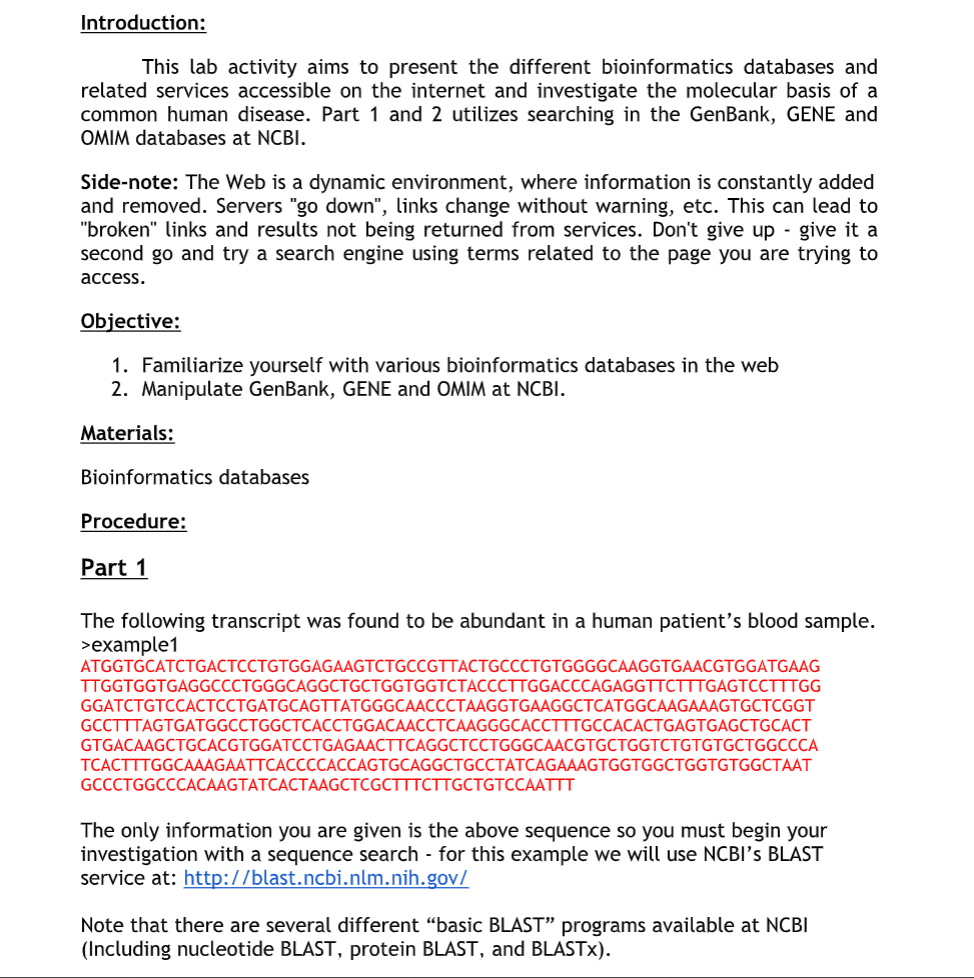From the results of your BLAST search you can link to the GENE entry for one of your top hits. This link is located under the “Related Information” heading at the right hand side of each displayed alignment (i.e. scroll down to the “Alignments” section). QUESTION What is the “Official Symbol” and “Official Full Name” for this gene?
From the results of your BLAST search you can link to the GENE entry for one of your top hits. This link is located under the “Related Information” heading at the right hand side of each displayed alignment (i.e. scroll down to the “Alignments” section). QUESTION What is the “Official Symbol” and “Official Full Name” for this gene?
Human Heredity: Principles and Issues (MindTap Course List)
11th Edition
ISBN:9781305251052
Author:Michael Cummings
Publisher:Michael Cummings
Chapter15: Genomes And Genomics
Section: Chapter Questions
Problem 7QP: Which of the following is NOT an activity carried out in the field of bioinformatics? a. collecting...
Related questions
Question
From the results of your BLAST search you can link to the GENE entry for one of your top hits. This link is located under the “Related Information” heading at the right hand side of each displayed alignment (i.e. scroll down to the “Alignments” section).
QUESTION
- What is the “Official Symbol” and “Official Full Name” for this gene?

Transcribed Image Text:Introduction:
This lab activity aims to present the different bioinformatics databases and
related services accessible on the internet and investigate the molecular basis of a
common human disease. Part 1 and 2 utilizes searching in the GenBank, GENE and
OMIM databases at NCBI.
Side-note: The Web is a dynamic environment, where information is constantly added
and removed. Servers "go down", links change without warning, etc. This can lead to
"broken" links and results not being returned from services. Don't give up - give it a
second go and try a search engine using terms related to the page you are trying to
access.
Objective:
1. Familiarize yourself with various bioinformatics databases in the web
2. Manipulate GenBank, GENE and OMIM at NCBI.
Materials:
Bioinformatics databases
Procedure:
Part 1
The following transcript was found to be abundant in a human patient's blood sample.
>example1
ATGGTGCATCTGACTCCTGTGGAGAAGTCTGCCGTTACTGCCCTGTGGGGCAAGGTGAACGTGGATGAAG
TTGGTGGTGAGGCCCTGGGCAGGCTGCTGGTGGTCTACCCTTGGACCCAGAGGTTCTTTGAGTCCTTTGG
GGATCTGTCCACTCCTGATGCAGTTATGGGCAACCCTAAGGTGAAGGCTCATGGCAAGAAAGTGCTCGGT
GCCTTTAGTGATGGCCTGGCTCACCTGGACAACCTCAAGGGCACCTTTGCCACACTGAGTGAGCTGCACT
GTGACAAGCTGCACGTGGATCCTGAGAACTTCAGGCTCCTGGGCAACGTGCTGGTCTGTGTGCTGGCCCA
TCACTTTGGCAAAGAATTCACCCCACCAGTGCAGGCTGCCTATCAGAAAGTGGTGGCTGGTGTGGCTAAT
GCCCTGGCCCACAAGTATCACTAAGCTCGCTTTCTTGCTGTCCAATTT
The only information you are given is the above sequence so you must begin your
investigation with a sequence search - for this example we will use NCBI's BLAST
service at: http://blast.ncbi.nlm.nih.gov/
Note that there are several different "basic BLAST" programs available at NCBI
(Including nucleotide BLAST, protein BLAST, and BLASTX).
Expert Solution
This question has been solved!
Explore an expertly crafted, step-by-step solution for a thorough understanding of key concepts.
This is a popular solution!
Trending now
This is a popular solution!
Step by step
Solved in 3 steps

Knowledge Booster
Learn more about
Need a deep-dive on the concept behind this application? Look no further. Learn more about this topic, biology and related others by exploring similar questions and additional content below.Recommended textbooks for you

Human Heredity: Principles and Issues (MindTap Co…
Biology
ISBN:
9781305251052
Author:
Michael Cummings
Publisher:
Cengage Learning

Human Heredity: Principles and Issues (MindTap Co…
Biology
ISBN:
9781305251052
Author:
Michael Cummings
Publisher:
Cengage Learning